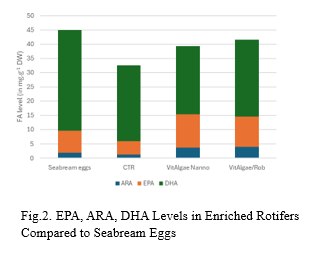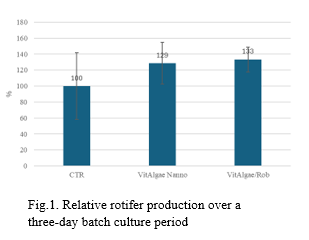SIMPLIFIED ROTIFER PRODUCTION: A KEY TO HIGH-QUALITY ROTIFER ENRICHMENT
Introduction
The production of high-quality live food remains a key success factor in many hatcheries for marine finfish species. The required rotifer quantities, needed to successfully produce fish larvae, have decreased in the last years, thanks to the development of high-quality, partial rotifer substitution diets such as Natura pRo (INVE Aquaculture, Thailand). Because of this trend, it is of uttermost importance that the provided rotifers are of high nutritional and microbial quality and that the procedures to produce them are easy and limited in time. In this work is presented how rotifer culture and enrichment combinations, using the correct products, can result in optimal live prey for the rearing of Seabream larvae.
Materials and methods
Rotifer culture and enrichment
L-type rotifers were cultured in cylindroconical tanks of 850L at a temperature of 26°C and a salinity of 25ppt. The culture tanks were equipped with aeration in order to provide a homogeneous distribution of the rotifers and rotifer diets. Dissolved oxygen levels were kept between 80 and 150% of saturation. Rotifers were cultured using three different feed combinations, each designed to optimize the cultivation process:
- 90% Fresh Baker’s Yeast/10% RoBoost = (Control or CTR)
- 100% VitAlgae Nanno (=Vitalgae Nanno)
- 90% VitAlgae Nanno/10% RoBoost (=Vitalgae/Rob)
The required rotifers for Seabream larvae were enriched directly in the same culture medium, without a harvesting or rinsing step, at a density of 1000-1500 rotifers per ml. This enrichment was performed using Easy Dry Selco (INVE Aquaculture, Thailand), up to 2x145 ppm for a duration of 12 hours. At harvest, rotifers were rinsed and stored in cold storage (6-8°C) for the different feedings during the day.
Seabream Larval rearing
For each treatment, three replicate tanks of 1000L were stocked with 80 000 just-hatched Seabream larvae, all originating from the same pool of eggs. The larvae were reared at a temperature of 19±0.5°C in seawater with a salinity of 38ppt. From 3 to 20 days post hatch (dph), approximately 60-70g of VitAlgae Nanno per m³ were added daily to the tanks followed by a daily ratio of 15 grams of Sanolife GWS (INVE Aquaculture, Thailand) per m3 between 21 and 30dph. In all tanks, the larvae were fed following the traditional feeding protocol, using rotifers (produced according to the three different treatments) from 3 to 30dph, AF SEP-Art Artemia from 16 to 26dph and EG SEP-Art, enriched with Easy Dry Selco, from 23 to 55dph. At 19dph a dry diet (O.Range, INVE Aquaculture, Thailand) was introduced and fed until the end of weaning (55dph).
Evaluation parameters
The growth performance and nutritional profile of the rotifers were evaluated for all treatments.
For the Seabream larvae, survival rate, growth parameters, stress resistance, deformity levels and FAME values were assessed. Larvae were weaned at 55 dph and fish from all tanks were graded to determine the survival and quality of the fry produced.
Results
The average rotifer production over a three-day batch culture period, expressed in millions of rotifers reproduced per 1000 liters, was approximately 30% higher for treatments containing VitAlgae Nanno compared to the control treatment (see Fig.1).
FAME analyses for the essential fatty acids performed on the Seabream eggs and on the enriched rotifers from the three treatments, are presented in Fig.2. The sum of essential fatty acids (EPA, ARA and DHA) present in rotifers enriched with Easy Dry Selco directly in the rotifer culture medium after using VitAlgae Nanno either at 100% or as 90% (with 10% Rob), is similar to the levels found in Seabream eggs, and higher compared to the control rotifers. Regarding the performance of the Seabream larvae, all treatments yielded similar survival rates. The growth rate at the end of the rotifer phase was slightly higher for the treatments using VitAlgae Nanno, compared to the control treatment, as evidenced by both length and dry weight measurements. At 30 dph, fish larvae from treatments containing VitAlgae Nanno demonstrated better resistance when exposed to a salinity stress test than the control larvae, however, these differences were not apparent by the end of the weaning period. Histological staining analysis of early deformity levels at a total length of 10-12mm, did not reveal any differences between the treatments.
Conclusions
These results highlight the importance of high-quality rotifer culture and enrichment products in maintaining optimal larval development and performance, especially as the quantity of rotifers used in larval fish protocols decreases due to the introduction of new larval diets. As a conclusion it can be stated that the use of VitAlgae Nanno, RoBoost and Easy Dry Selco, applied during a combined culture and enrichment process for rotifers, results in a rotifer quality that is suitable for a successful larval rearing of Seabream larvae. These procedures, significantly reduce the manpower and resources, needed to produce high-quality rotifers without compromising the quality of the fry produced.

